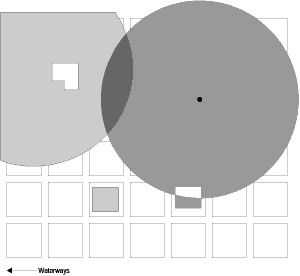
ST_SymmetricDiff takes two geometry objects and returns a geometry object that is the symmetrical difference of the source objects.
Syntax
db2gse.ST_SymmetricDiff(g1 db2gse.ST_Geometry, g2 db2gse.ST_Geometry)
Return type
db2gse.ST_Geometry
Examples
The county supervisor must determine the area of sensitive areas and five-mile hazardous site radius that is not intersected.
The following CREATE TABLE statement creates the SENSITIVE_AREAS table, which contains several columns that describe the threatened institutions. The SENSITIVE_AREAS table also contains the ZONE column, which stores the institution's polygon geometry.
CREATE TABLE SENSITIVE_AREAS (id integer,
name varchar(128),
size float,
type varchar(10),
zone db2gse.ST_Polygon);
The following CREATE TABLE statement creates the the HAZARDOUS_SITES table, which stores the identity of the sites in the SITE_ID and NAME columns, while the actual geographic location of each site is stored in the LOCATION point column.
CREATE TABLE HAZARDOUS_SITES (site_id integer,
name varchar(128),
location point);
The ST_Buffer function generates a five-mile buffer surrounding the hazardous waste site locations. The ST_SymmetricDiff function generates polygons from the intersection of the buffered hazardous waste site polygons and the sensitive areas. The ST_Area function returns the intersection polygon's area for each hazardous site.
SELECT sa.name, hs.name,
db2gse.ST_Area(db2gse.ST_SymmetricDiff (db2gse.ST_Buffer(hs.location,
(5 * 5280)),sa.zone))
FROM HAZARDOUS_SITES hs, SENSITIVE_AREAS sa
 |
In Figure 38, the symmetric difference of the hazardous waste sites and the sensitive areas results in the subtraction of the intersected areas.